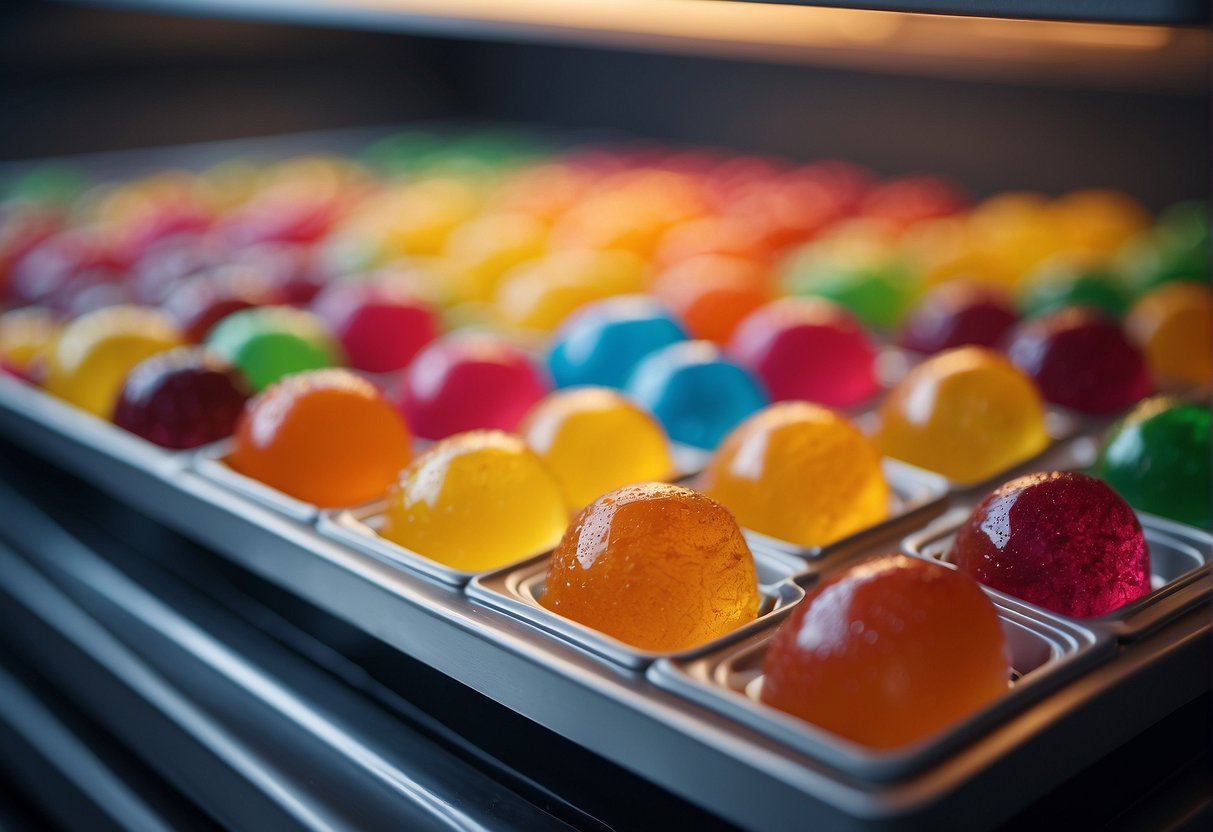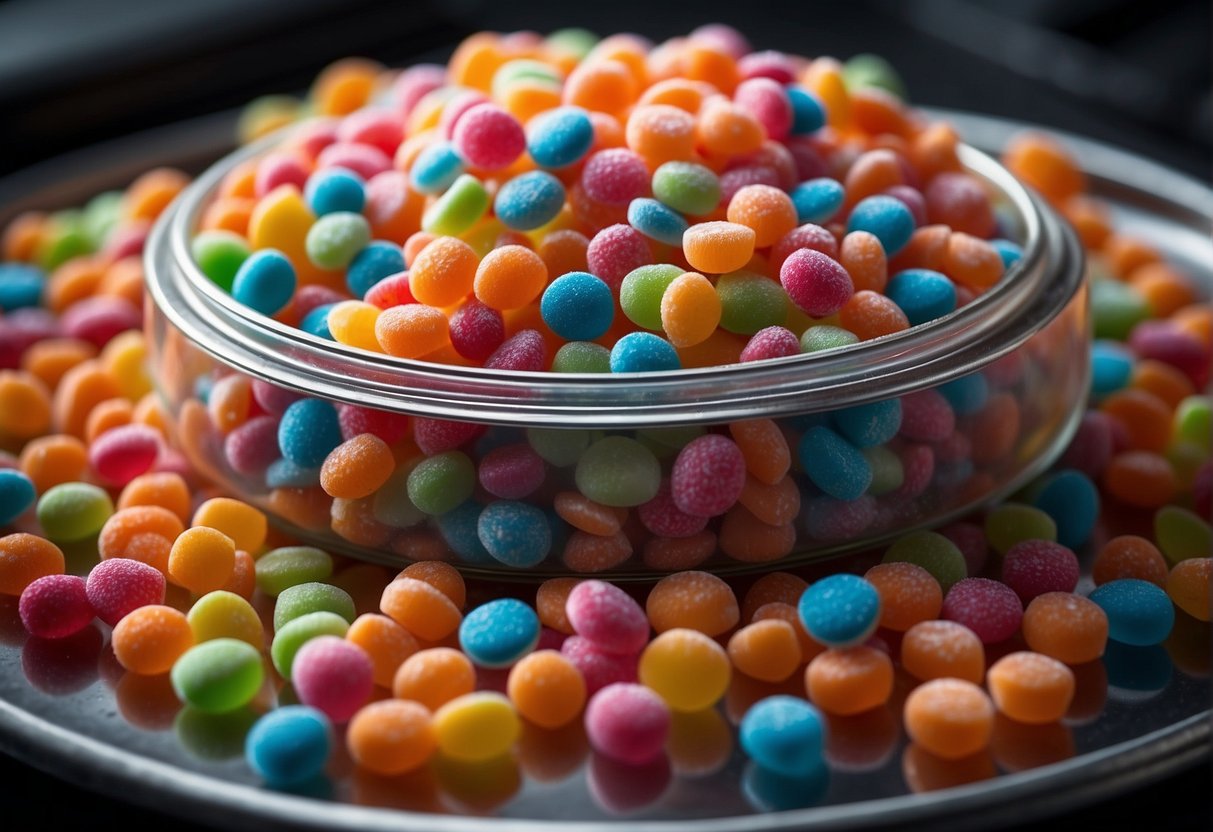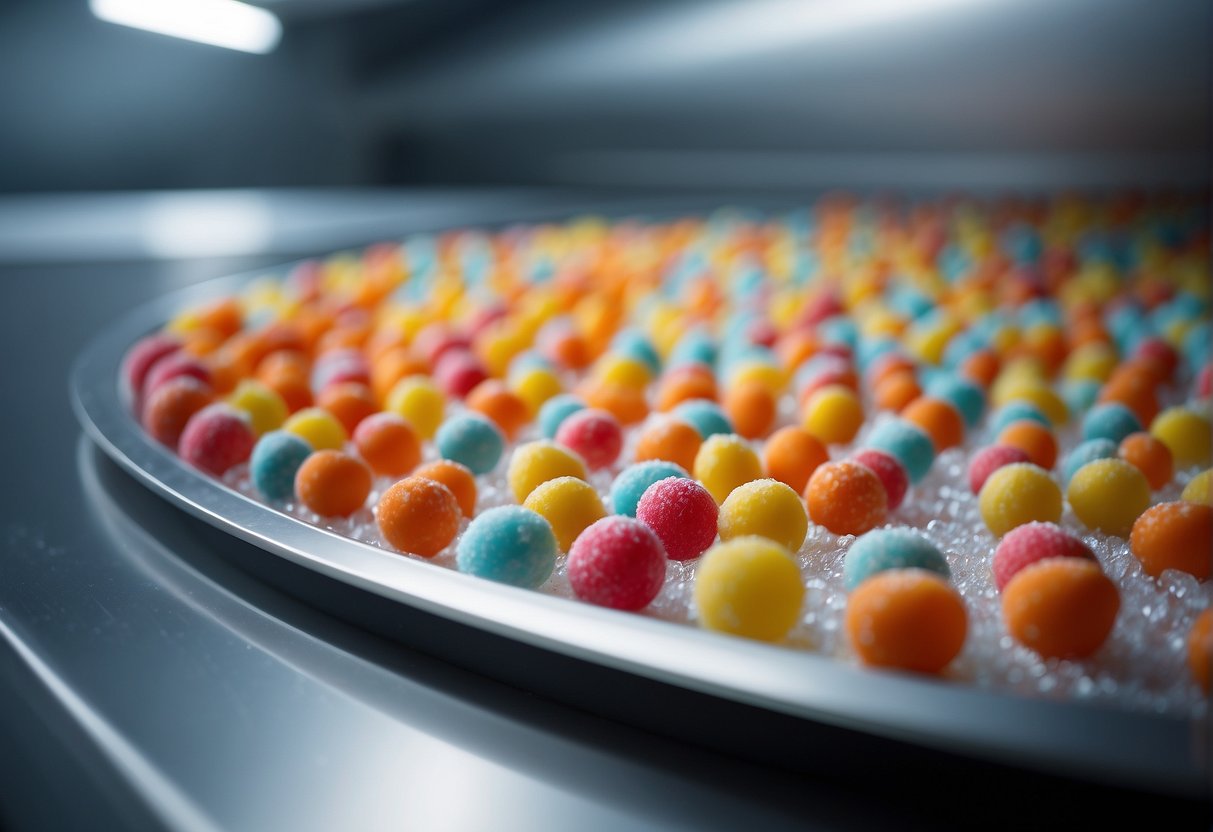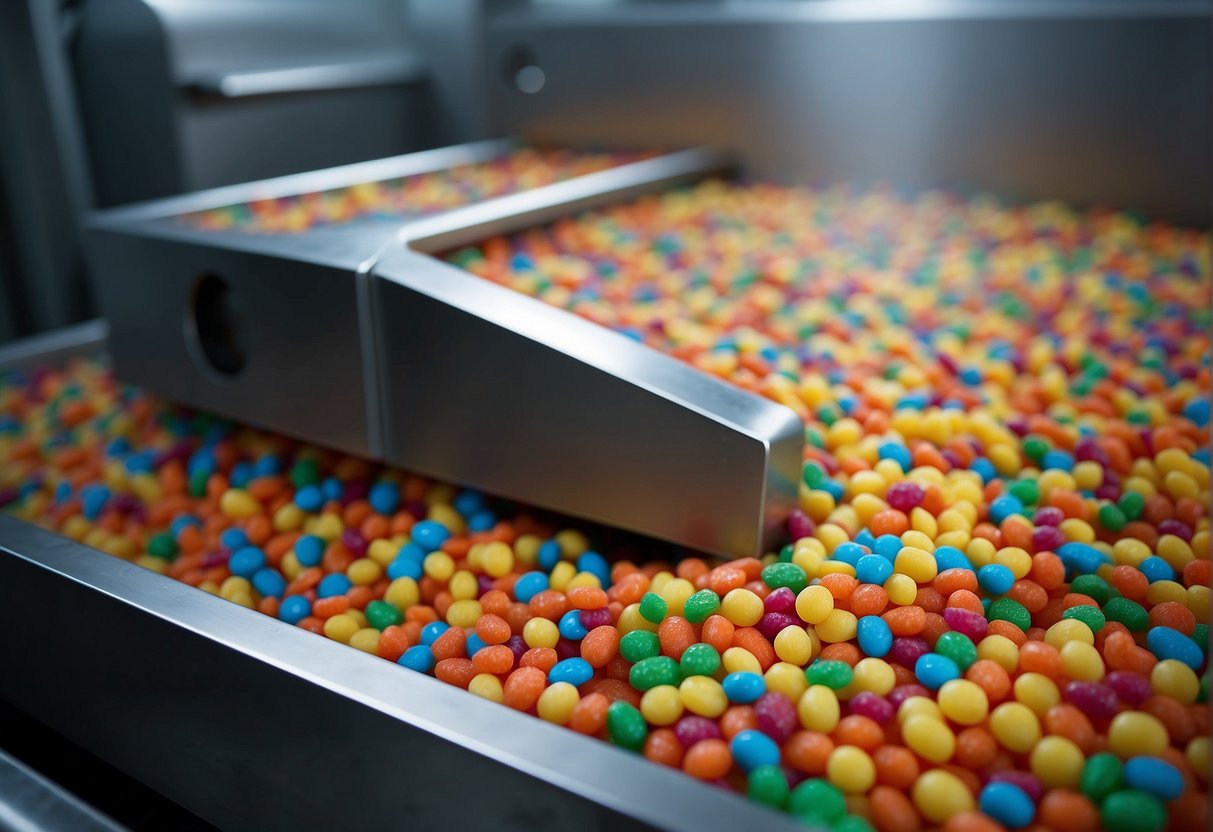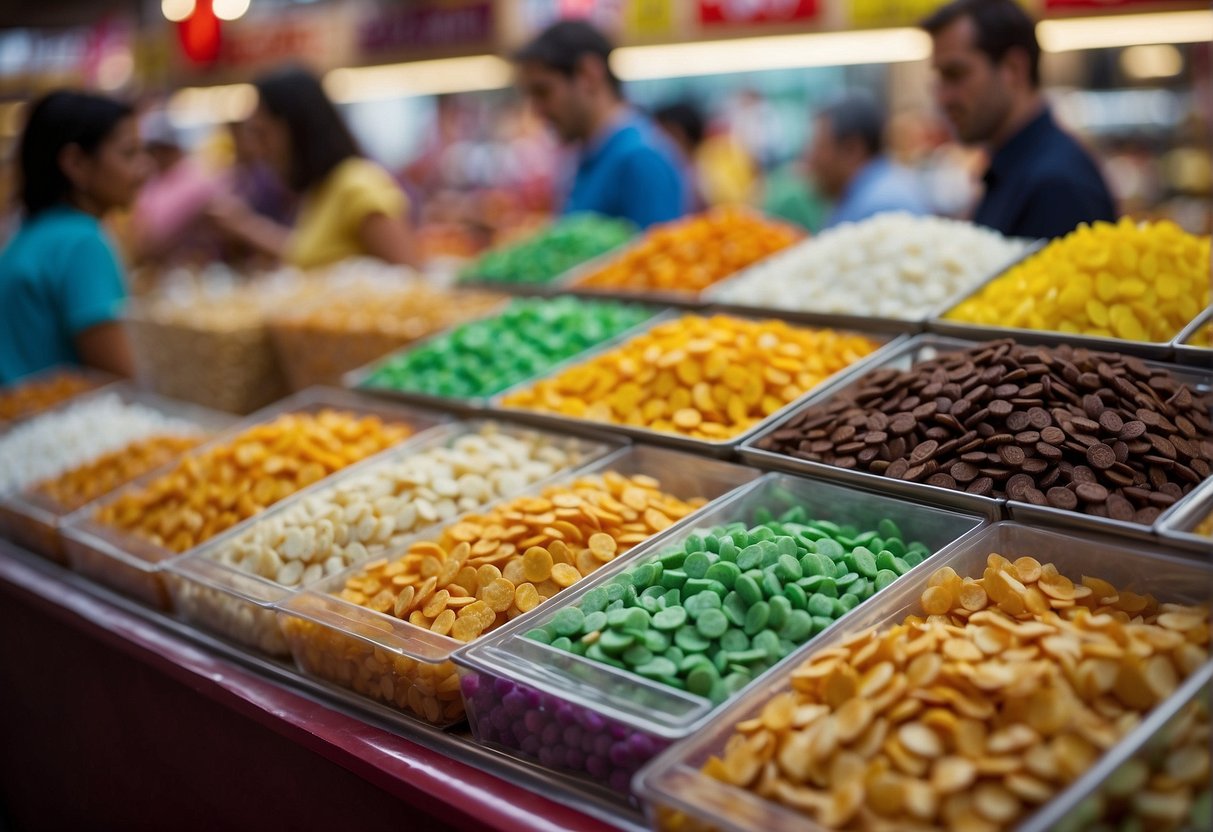Freeze dried candy is a type of confectionery that has undergone a process known as freeze drying or lyophilization. This method removes moisture from the candy, resulting in a lightweight, crunchy texture that differentiates it from its conventional counterparts.
The transformation that freeze-dried candy undergoes not only alters its texture but also often intensifies its flavors, making it a unique treat from brands such as Kanpai Foods.
The science behind freeze drying is both precise and intricate. It involves first freezing the candy to a temperature between -30 and -50 degrees Fahrenheit, which preserves its original shape and size. Following the freezing stage, the candy is placed under a vacuum, allowing the frozen water inside the candy to sublimate directly from ice to vapor without passing through a liquid phase. This transition ensures that the candy retains maximum flavor without compromising its nutritional content.
Due to the complex nature of the process and the equipment required, freeze-dried candy is typically more expensive than traditional candy. However, its distinct characteristics have made freeze dried candy popular among those looking to explore novel food textures and flavors. Although the freeze-drying method was originally developed for preserving pharmaceuticals and biological samples, it has since been adopted by the food industry and is now applied to a variety of popular foods, including fruits, vegetables, and sweets.
Overview of Freeze Drying
Freeze drying, also known as lyophilization, is a dehydration process typically used to preserve perishable material or make it more convenient for transport. It employs sublimation under vacuum conditions to effectively remove water content.
History and Development
The concept of freeze drying has its origins as far back as the ancient Incas, who stored their crops in the high Andean mountains, where night temperatures would drop below freezing. The application of freeze drying expanded considerably during World War II for preserving blood plasma and penicillin. Since then, the development of industrial freeze drying has opened new horizons in food preservation, including the creation of freeze-dried candy.
Basic Principles of Freeze Drying
Freeze drying is predicated on the scientific principle of sublimation, where ice transforms directly into vapor without transitioning through a liquid state. The basic process involves:
- Freezing: The material is cooled to well below freezing point, forming ice crystals.
- Vacuum Creation: The product is placed under a vacuum, which lowers the pressure around the item.
- Sublimation: Under these conditions, the ice sublimates; water vapor is then drawn off into a condenser.
A freeze dryer facilitates this process, ensuring that the material’s structure and nutrients are well preserved while radically extending its shelf-life.
Modern Applications
Freeze drying has contemporary applications spanning various industries, from pharmaceuticals to food technology. Its adoption for creating freeze-dried candy underlines its versatility, offering a product that is lightweight, has a prolonged shelf life, and retains the original flavors and nutritional value of the candy. As such, freeze-dried treats have become popular among consumers who enjoy a unique, crunchy texture that differs from traditional candy.
The Freeze Drying Process
Freeze-dried candy is produced through a meticulous process involving specific stages to ensure the candy retains its flavor and texture. The freeze-drying process uses low temperatures and vacuum pressure to remove moisture from candy, a method different from traditional dehydration.
Pre-Freezing Stage
In the pre-freezing stage, the candy is first cooled to temperatures between -30 and -50 degrees Fahrenheit. This low temperature ensures that the candy is completely solidified before drying begins, which is crucial for maintaining its shape and flavor.
Primary Drying Phase
During the primary drying phase, a vacuum pump lowers the pressure around the candy. Sublimation occurs as a result, where the frozen water in the candy transitions directly from a solid to a gas. This is done in a freeze-drying machine, which controls the temperature and pressure carefully to optimize the drying process.
Secondary Drying Phase
The secondary drying phase aims to remove any remaining moisture. The temperature is raised higher than in the primary phase, and the vacuum pressure is maintained. This removes bound water molecules, further reducing the water content without compromising the candy’s structure.
Packaging and Storage
Once the freeze-drying process is complete, it’s important to package the candy properly to prolong its shelf life. The candy is allowed to cool to room temperature, then placed in airtight containers or bags to protect it from humidity and contaminants. This packaging ensures the candy remains crisp and flavorful for consumption.
Equipment and Technology
The right equipment and technology are foundational for the freeze-drying process, whether for individual or commercial use. Efficient freeze-drying relies on sophisticated machinery designed to maintain low temperatures and high vacuum conditions.
Home Freeze Dryers
Home freeze dryers are becoming increasingly popular for domestic use. They typically comprise a vacuum chamber, condenser, vacuum pump, and heater. These dryers are smaller and more user-friendly, designed to fit on a countertop. An individual can operate them easily, often with one-touch controls, and they come with freeze dryer trays where candy is placed before the drying process starts.
Commercial Freeze Dryers
In a business setting, commercial freeze dryers are designed for higher volume output, equipped with advanced features to handle larger batches of candy. These units are significantly larger and require more space and infrastructure. They contain multiple shelves to accommodate more trays, a more powerful vacuum pump to effectively remove air and moisture, and a potent refrigeration system to maintain necessary freezing temperatures throughout the process.
Key Technological Components
Key components of freeze-drying equipment include:
- Vacuum Pump: Essential for creating the vacuum within the dryer, allowing sublimation to occur.
- Condenser: Cools the vapor produced during sublimation and turns it back into ice.
- Control System: Regulates temperatures and pressure levels precisely during freeze-drying.
- Shelves/Trays: Specially designed for evenly spreading candy so it can freeze dry uniformly.
Types of Freeze Dried Candy
Freeze-dried candy comes in various forms, transitioning beloved treats into novel textures and intensifying their flavors. This process is applied to a wide array of confectioneries, creating unique snacking experiences with a longer shelf life.
Fruit-Based Candies
Skittles: Once freeze-dried, Skittles transform from their original chewy texture into an airy, crisp delight with concentrated sweetness.
Starburst: These fruit chews adopt a fragile, yet satisfying crunch post freeze-drying, enhancing their fruity essence.
Chocolate and Marshmallows
Chocolate: Typically, chocolates aren’t the primary choice for freeze-drying due to their high fat content, which behaves differently than water under freeze-drying.
Marshmallows: A popular option for freeze-drying, marshmallows puff up and attain a light, crunchy texture, making them an intriguing version of the classic treat.
Gummies and Chewy Candies
Gummies: Experience an unusual crunchy twist to the usual squishy gummies, ranging from bears to worm shapes.
Taffy: The pull-apart staple of seashores, taffy turns into a melting flaky treat when freeze-dried, juxtaposing its original texture.
Hard Candies and Taffy
Jolly Ranchers: These hard candies maintain their vibrant flavors while becoming more brittle and shard-like.
Candy Corn: A Halloween favorite, candy corn can be freeze-dried to add an unexpected, crunchy edge to its creamy texture.
Characteristics of Freeze Dried Candy
Freeze-dried candy showcases distinct properties that set it apart from traditional confections. Through the removal of moisture, it takes on new textural qualities and intensified flavors while also altering its nutritional profile.
Texture and Consistency
The process of freeze-drying transforms the candy’s texture and consistency significantly. Once moisture is removed, these candies become crunchy and light, offering a unique eating experience. The initial firmness quickly gives way to a melt-in-your-mouth sensation as the candy rehydrates from saliva.
Flavor Profile
Due to the low moisture content, freeze-dried candy has a concentrated flavor. The high sugar content becomes more pronounced, delivering a delicious and rich taste experience. As water is a diluent for flavor, its absence means that the flavors remaining in the candy are experienced more intensely by the taste buds.
Nutritional Changes
The caloric value of candy does not change significantly through freeze-drying; however, due to its crunchy texture, such candy might be less dense and therefore may be perceived as lighter in calories. Essentially, the nutritional elements remain the same, but the reduced water weight can result in consumers enjoying smaller portions of the same treat, possibly reducing overall calorie intake.
Benefits and Drawbacks
When evaluating freeze-dried candy, it’s essential to consider factors such as how long it lasts, the sensory experience it offers, and the practical aspects of cost and sourcing. These factors can significantly influence a consumer’s choice.
Shelf Life and Preservation
Freeze-dried candy boasts an impressive shelf life, thanks to the lack of moisture that inhibits bacterial and mold growth, this is another reason why consumers buy freeze dried candy online. The typical preservation method involves freezing the candy, then placing it in a vacuum chamber to remove water through sublimation. This method of preservation can extend the candy’s freshness for years, making it exceptional for long-term storage.
- Shelf Life: Often lasts for years if stored correctly
- Preservation Method: Involves freeze-drying to remove water content
Taste and Nutritional Benefits
Consumers may find freeze-dried candy to have a more concentrated flavor compared to traditional candy. The removal of water tends to intensify taste, offering a unique experience. Nutritionally, this process does not generally add extra preservatives or additives, which can appeal to those seeking purer snack options. However, it’s vital to note that the drying process doesn’t reduce the sugar content.
- Flavor: More intense than in their non-dried counterparts
- Nutritional Aspect: No added preservatives; sugar content remains unchanged
Cost and Availability
While freeze-dried candy can be seen as exotic and enjoyable, it also tends to be more expensive than conventional candy. This increased cost is due to the specialized equipment and energy required for the freeze-drying process. Availability may vary, with some products like astronaut ice cream being more commonly found in specialty stores or online.
- Cost: Generally higher than regular candy
- Availability: Can be limited, often found in specialized stores or online
DIY Freeze Drying Candy
Freeze drying candy at home can be accomplished with the right equipment and procedure. This section will guide through choosing the appropriate tools for the job, provide a detailed step-by-step guide, and share tips to achieve the best results.
Choosing the Right Equipment
For those interested in freeze drying candy at home, the primary requirement would be a home freeze dryer. While this can be an investment, it’s crucial for achieving the sublimation process that freeze-dried treats require. Alternatively, a cooler and dry ice can be employed for a DIY approach. For preparation, one will need parchment paper to line the trays and a deep freezer to pre-freeze the candy.
Step-By-Step Guide
- Preparation: Begin by arranging the candy in a single layer on trays lined with parchment paper and pre-freeze in the deep freezer for several hours or overnight.
- Freeze Drying with a Machine:
- Transfer the frozen candy into the home freeze dryer.
- Space the candy pieces to ensure adequate airflow.
- Set the home freeze dryer according to the manufacturer’s instructions and start the cycle, which usually spans 24 to 48 hours.
- Freeze Drying with Dry Ice:
- Place the pre-frozen candy along with dry ice in a cooler, ensuring minimal air space.
- Seal the cooler but allow for a small vent to let gas escape.
- After about 24 hours, or when the dry ice has sublimated, transfer the cooler contents to the freezer for another 24 hours to complete the process.
Tips for Best Results
- Consistent Sizing: Ensure the candy pieces are of uniform size to promote even drying.
- Adequate Spacing: In the freeze dryer, adequate spacing is crucial for uniform sublimation.
- Trial and Error: Each type of candy may require a different freeze drying time; keep notes of the specific times for consistently perfect freeze-dried treats.
Commercial Production
In the commercial production of freeze-dried candy, large-scale operations utilize specialized equipment to remove moisture and create a shelf-stable product. These businesses adhere to strict quality control measures to ensure consistency, safety, and compliance with industry standards.
Large-Scale Operations
Large-scale operations for freeze-drying candy involve a systematic process that maximizes efficiency and output. These businesses typically produce in bulk, using sophisticated machinery designed for mass production. They closely monitor the freeze-drying cycle to maintain the desired texture and flavor of the candies.
Equipment for Mass Production
Key Machines in Commercial Freeze-Drying:
- Freeze Dryer: The primary machine used for removing moisture from candy under low pressure and temperature.
- Dehydrator: An alternative or supplementary machine for removing residual moisture content.
- Food Processor: Used pre- or post-freeze-drying for sizing and mixing ingredients.
- Packaging Equipment: Ensures candies are sealed in airtight containers for distribution.
Note: High-quality, commercial-grade machines are essential for businesses to ensure efficient production and maintain product quality.
Quality Control Measures
Businesses implement various quality control measures to uphold product standards and adhere to industry regulations. These include:
- Sanitation Protocols: Regular cleaning of machinery and facilities to prevent contamination.
- Consistency Checks: Ensuring that each batch of freeze-dried candy meets the set texture, taste, and appearance criteria.
- Labeling Compliance: Accurate product labels reflecting ingredients, nutritional information, and expiration dates.
Cultural and Market Impact
The emergence of freeze-dried candy has not only rejuvenated consumer interest in confectioneries but has also catalyzed a shift in purchase behavior and cultural relevance, especially during key seasons and among various groups.
Popularity and Trend Analysis
Freeze-dried candy has seen a significant rise in popularity, becoming a novel trend especially in places like state fairs and summer festivals. Market trends reveal a broadening customer base, ranging from nostalgic candy lovers to curious homesteaders looking for innovative ways to preserve food. A notable example includes an impressive 1,600% increase in searches for freeze-dried candy, indicating a robust and growing interest.
The Role in Modern Diets
In modern diets, freeze-dried candy has carved out a niche, offering a unique eating experience with a longer shelf life. Its lightweight and dehydrated nature appeals to those seeking convenience without compromising taste. Brands like RJ Pantry and Brightside Skittles have adapted their offerings to meet this demand, providing a fusion of traditional flavors and modern preservation techniques.
Marketing Strategies
Companies are diversifying their marketing strategies to capitalize on the trend. They are aligning their products with cultural moments and nostalgic experiences. Lucky Charms, for instance, has leveraged their iconic marshmallows by offering them in a freeze-dried form, resonating with both younger consumers and adults who grew up with the brand. Marketing strategies often highlight the novelty and the vibrant, intensified flavors that freeze-drying brings to the candies.
SEE ALSO: Bringing CBD Edibles into Thailand: Essential Information for Tourists
⚠ Article Disclaimer
The above article is sponsored content any opinions expressed in this article are those of the author and not necessarily reflect the views of CTN News


